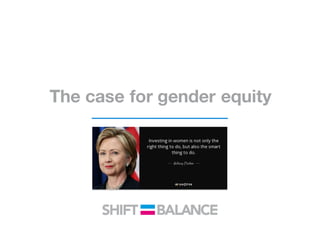
The case for gender equity
- 1. The case for gender equity
- 4. WEF studies prove that GDP per capita actually correlates with Global Gender Gap Part 1: The Global Gender Gap and its Implications Slovak Republic. In six countries there were gains of more than 10%: Bangladesh, Belgium, Denmark, Finland, Ireland and Switzerland. Figure B1 displays these changes the Global Competitiveness Index 2014-2015 and Global Gender Gap Index 2014. The graphs confirm a correlation between gender equality and GDP per capita, GDPpercapita(constant2005international$) Figure 25: GDP per capita vs Gobal Gender Gap Index 2014 Source: Global Gender Gap Index 2014 and the World Bank’s World Development Indicators (WDI) online database, accessed July 2014. Note: The Global Gender Gap Index axis has been truncated to enhance readability. 0.5 0.6 0.7 0.8 0.9 0 30,000 60,000 90,000 120,000 150,000 Qatar Norway Iceland Philippines Nicaragua BurundiLesotho Russian Federation Brazil Switzerland Kuwait Luxembourg China India Saudi Arabia Pakistan Chad SwedenIreland New Zealand Yemen Finland Singapore Global Gender Gap Index 2014 score (0.00-1.00 scale) GDPpercapita,PPP(constant2011international$)
- 5. common myths About Working Women Relationship between GDP per capita and the Global Gender Gap Index 2013 score Source: Global Gender Gap Index 2013 and the World Bank’s World Development Indicators (WDI) online database, accessed May 2013. Note: The Global Gender Gap Index has been truncated to enhance readability GDPpercapita(constant2005international$) Qatar Norway Iceland Nicaragua Philippines Lesotho Russian Federation Brazil Switzerland China India Saudi Arabia Pakistan Sweden Yemen Finland 0.50 0.55 0.60 0.65 0.70 0.75 0.80 0.85 0.90 0 20,000 40,000 60,000 80,000 Global Gender Gap Index 2013 score (0.00–1.00 scale)
- 6. Booz & Company September 2012 1 649.3 98.8 64.2 Close to 1 Billion women, the “Third Billion,” will enter the global economy during the coming decade Overview of the Third Billion Source: ILO data; Booz & Company analysis 45.0 6.9 0.9 … Women that have received neither sufficient education nor social/political support Women that have not received sufficient education Women that have not received sufficient social/political support Neither Prepared nor Enabled Not Enabled Not Prepared Developed Economies Emerging Economies … Women outside the Economic System (2020, in millions) 865 million women will enter the economic mainstream in the coming decade, constituting the Third Billion—in reference to the billion-plus respective populations of China and India
- 7. Booz & Company Our estimates confirm the significant untapped economic growth potential that the Third Billion represents September 2012 Potential Economic Impact of Women’s Economic Empowerment GDP Impact of Matching Female to Male Employment Rates (% of GDP) U.S. 5% U.K. 5% Japan 9% South Africa 10% Argentina 12% IndiaEgypt 12% 27% 34% UAE Source: Booz & Company analysis Angel Gurria Secretary General, OECD Caroline Anstey MD, World Bank “Gender equality is good in and of itself, and it is smart economics.” “Women are the most underutilized economic asset in the world’s economy.” Emerging Economies Developed Economies Matching female to male employment rates would significantly increase GDP in emerging economies— where opportunities for women today are limited 2
- 8. Gender Equality an ‘Economic No-Brainer,’ Says IMF Chief
- 16. $2.1 trillionin additional GDP in 2025 if all US states match the states with the fastest progress toward gender parity in work over the past decade—a best-in-class scenario. This is 10 percent higher GDP, or a 3.1 percent growth rate through 2025, instead of the 2.3 percent growth rate in the business-as-usual scenario. 40/30/30. About 40 percent of the $2.1 trillion GDP opportunity comes from a higher female labor-force participation rate, 30 percent from narrowing the gap between men and women who work part time and full time, and 30 percent from changing the mix of sectors in which women work to boost their presence in more productive ones. An additional 6.4 million jobswould be required to secure the additional GDP. Jobs would be created at a rate of 1.0 percent a year in the period to 2025, compared with 0.6 percent in the business-as-usual scenario. GDP increase for all states. Every US state can achieve at least 5 percent higher GDP in 2025 by matching best-in-class improvement rates between women and men in work, and half (25 states) can achieve 10 percent or more.
- 19. THE GENDER DIVIDEND A BUSINESS CASE FOR GENDER EQUALITY
- 22. Yet, we’d better be patient…
- 24. 117 years until gender parity? Put gender on your agenda. In its Global Gender Parity Report 2015, the World Economic Forum estimates it will take 117 years to achieve gender parity in the workplace. How can we accelerate this pace? We surveyed men and women leaders from 400 companies around the world to help illuminate the way forward and blended their recommendations with our experience to create the following accelerators. Accommo work/life for all Speed up company culture change with progressive corporate policy for advan make role visible an leadershi programs Illuminate the path to leadership Accelerators How Three accelerators for women in the w
